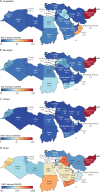The burden of neurological conditions in north Africa and the Middle East, 1990-2019: a systematic analysis of the Global Burden of Disease Study 2019
- PMID: 38604203
- PMCID: PMC11099299
- DOI: 10.1016/S2214-109X(24)00093-7
The burden of neurological conditions in north Africa and the Middle East, 1990-2019: a systematic analysis of the Global Burden of Disease Study 2019
Abstract
Background: The burden of neurological conditions in north Africa and the Middle East is increasing. We aimed to assess the changes in the burden of neurological conditions in this super-region to aid with future decision making.
Methods: In this analysis of the Global Burden of Diseases, Injuries, and Risk Factors Study 2019 data, we examined temporal trends of disability-adjusted life-years (DALYs; deaths and disabilities combined), deaths, incident cases, and prevalent cases of 14 major neurological conditions and eight subtypes in 21 countries in the north Africa and the Middle East super-region. Additionally, we assessed neurological DALYs due to 22 potentially modifiable risk factors, within four levels of classification, during the period 1990-2019. We used a Bayesian modelling estimation approach, and generated 95% uncertainty intervals (UIs) for final estimates on the basis of the 2·5th and 97·5th percentiles of 1000 draws from the posterior distribution.
Findings: In 2019, there were 441·1 thousand (95% UI 347·2-598·4) deaths and 17·6 million (12·5-24·7) neurological DALYs in north Africa and the Middle East. The leading causes of neurological DALYs were stroke, migraine, and Alzheimer's disease and other dementias (hereafter dementias). In north Africa and the Middle East in 2019, 85·8% (82·6-89·1) of stroke and 39·9% (26·4-54·7) of dementia age-standardised DALYs were attributable to modifiable risk factors. North Africa and the Middle East had the highest age-standardised DALY rates per 100 000 population due to dementia (387·0 [172·0-848·5]), Parkinson's disease (84·4 [74·7-103·2]), and migraine (601·4 [107·0-1371·8]) among the global super-regions. Between 1990 and 2019, there was a decrease in the age-standardised DALY rates related to meningitis (-75·8% [-81·1 to -69·5]), tetanus (-88·2% [-93·9 to -76·1]), stroke (-32·0% [-39·1 to -23·3]), intracerebral haemorrhage (-51·7% [-58·2 to -43·8]), idiopathic epilepsy (-26·2% [-43·6 to -1·1]), and subarachnoid haemorrhage (-62·8% [-71·6 to -41·0]), but for all other neurological conditions there was no change. During 1990-2019, the number of DALYs due to dementias, Parkinson's disease, multiple sclerosis, ischaemic stroke, and headache disorder (ie, migraine and tension-type headache) more than doubled in the super-region, and the burden of years lived with disability (YLDs), incidence, and prevalence of multiple sclerosis, motor neuron disease, Parkinson's disease, and ischaemic stroke increased both in age-standardised rate and count. During this period, the absolute burden of YLDs due to head and spinal injuries almost doubled.
Interpretation: The increasing burden of neurological conditions in north Africa and the Middle East accompanies the increasing ageing population. Stroke and dementia are the primary causes of neurological disability and death, primarily attributable to common modifiable risk factors. Synergistic, systematic, lifetime, and multi-sectoral interventions aimed at preventing or mitigating the burden are needed.
Funding: Bill & Melinda Gates Foundation.
Translations: For the Persian, Arabic and Turkish translations of the abstract see Supplementary Materials section.
Copyright © 2024 The Author(s). Published by Elsevier Ltd. This is an Open Access article under the CC BY 4.0 license. Published by Elsevier Ltd.. All rights reserved.
Conflict of interest statement
Declaration of interests We declare no competing interests.
Figures







References
-
- WHO . World Health Organization; 2022. World health statistics 2022: monitoring health for the SDGs, sustainable development goals.https://www.who.int/publications/i/item/9789240051157
-
- Knauss S, Stelzle D, Emmrich JV, Korsnes MS, Sejvar JJ, Winkler AS. An emphasis on neurology in low and middle-income countries. Lancet Neurol. 2019;18:1078–1079. - PubMed

